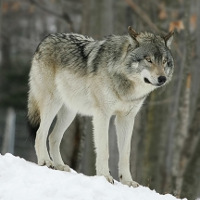 |
Gray wolf |
|
He is a wild animal |
Origin |
Mainly in Europe | |
Translation |
Francis Vandersteen |
| The possession of this animal is not authorized Royal Decree establishing the list of mammals not kept for production purposes that may be kept (M.B. 24.08.2009) |
| The gray wolf (Canis lupus) is the most widespread canid species. Other names : Loup commun or Loup vulgaire. However, the most common is simply "wolf", although this name also designates other canids. Over the course of history, the species has evolved into several subspecies, such as the European Grey Wolf (Canis lupus lupus), the Arctic Wolf (Canis lupus arctos) and others. Canis lupus was also the first animal to be domesticated by man, leading to the appearance of the Dog (Canis lupus familiaris) at least 33,000 years ago, while the wild hordes continued to evolve into today's gray wolves. From the dog, the subspecies of the Dingo (Canis lupus dingo) and the Singing Dog (Canis lupus hallstromi) returned to the wild. In its wild form, the Gray Wolf was gradually exterminated by man in several areas of its original range, particularly in the 19th century. In the 21st century, it is mainly found in "wide open spaces" such as the taiga, Siberian steppes and Canadian parks. It is now protected in many countries, where attempts are being made to preserve the remaining populations. Some conservation programs have enabled the Grey Wolf to return to areas where it had disappeared, particularly in North America. Conversely, the Canis lupus familiaris subspecies has spread worldwide. From being man's commensal, it gradually became the domesticated dog, itself diversified into multiple breeds adapted to the needs of those who created them. Wild wolves have always fascinated humans throughout history, fueling all areas of culture : mythology, literature, the arts, but also collective fears and fantasies. The species is known to have significant intra-specific variability between regions and subspecies, in terms of size, weight, coat and even the appearance of the snout. Wild subspecies are regularly compared with certain breeds of domestic dog of lupoid morphology, such as the German shepherd or the husky (themselves belonging to the Canis lupus familiaris subspecies). The most common morphotype features pointed ears above a broad head with an elongated muzzle terminating in a nose, a powerful mouth, a deep, narrow chest, long, extended legs with broad paws and a straight, bushy tail. Males are generally larger than females. Total length from muzzle to tip of tail averages 1.65 m for males and 1.59 m for females. Height at the withers varies from 66 to 81 cm. Adult Grey Wolves weigh an average of 16 to 50 kg for females and 20 to 70 kg for males, depending on the subspecies. The smallest subspecies is Canis lupus arabs, where males weigh an average of 18 kg, and one female holds the record for lightness at 12 kg. In contrast, a male weighing 96 kg was shot in the Carpathians in 1942, although this type of measurement remains exceptional. Two subpopulations of the great gray wolf can be distinguished empirically: the Eurasian plains wolf and the smaller Italian or Spanish wolf. The coat is dense, with abundant undercoat protected by guard hairs. In late spring, moulting reveals the summer coat, which thickens throughout the year to become the winter coat. The most common coat is a mixture of gray hairs darkened by black hairs. Although not melanism or leucism as in other species, these variations are not mutations and are part of the natural spectrum of coats. Similarly, the coat can range from brown to cream, russet and fawn. The chest, neck, lower jaw and inner parts of the limbs are lighter. The pack pursues herds of herbivores such as white-tailed deer, elk, bighorn sheep, reindeer, deer, elk and American bison in North America, and bighorn sheep, roe deer, red deer, fallow deer, chamois, European bison and wild boar in Europe. On both continents where wolves exist, grazers form the basis of their diet. To hunt, they pursue their prey over several kilometers, until it is exhausted. Solitary, they are content with small prey, such as small mammals (rodents) and birds. In autumn, wolves change their diet and consume large quantities of salmon, which are then in full run. Salmon fishing is far less dangerous than deer hunting. What's more, as winter approaches, salmon offers better nutritional quality in terms of fat and energy. Wolves can attack flocks of sheep. If the rest of the flock doesn't flee, the wolf will continue to hunt, in what is known as "surplus killing" or "over-killing". A wolf can kill several animals without eating them. |






 English (United Kingdom)
English (United Kingdom)